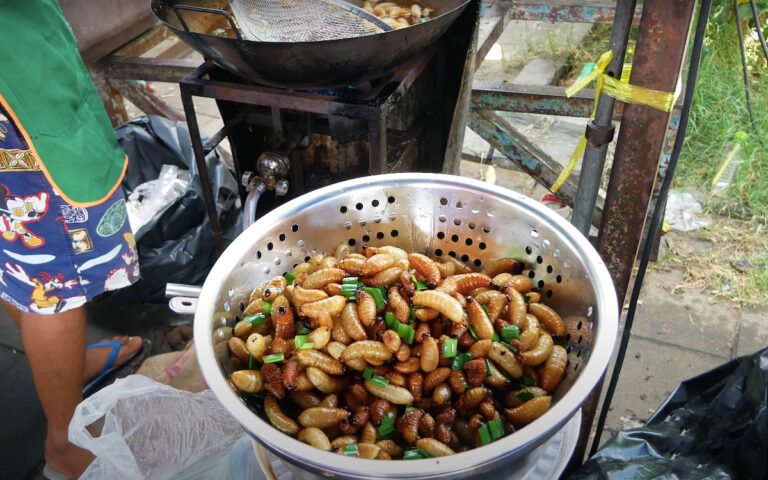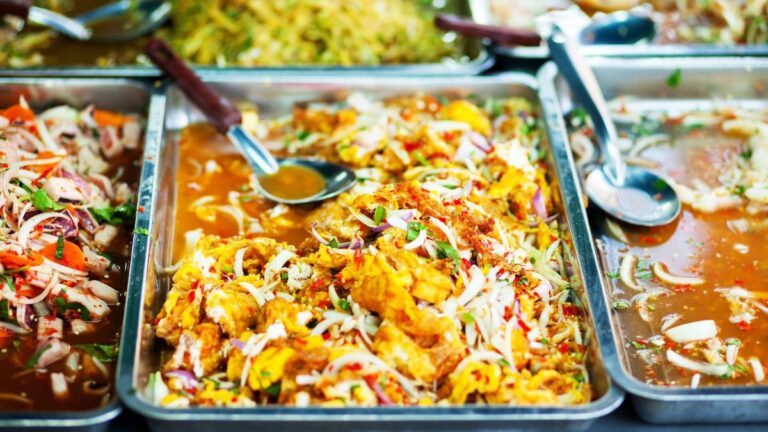What Thai Food Is Like
The traditional Thai diet is healthy and based around fish, remaining largely unaffected by the less desirable aspects of modern food culture. Thais generally eat meat sparingly, opting for generous portions of rice or noodles supplemented with a bit of meat and vegetables. This is a result of living in a land of abundant agriculture but with limited protein resources. Most tourists will find that fish, chicken, and pork are the most readily available sources of protein on menus. They are prepared in every way imaginable by skillful Thai cooks.
In this post, we will explore the most popular Thai food types, the ingredients used to cook them, and how cuisine varies by region.
A Guide to Common Thai Food
Prepared in Pots
This is a great way to get food for takeout. Many food vendors in markets are not in the business of feeding you onsite but rather send you home with the goods. Again, this has the benefit that you can point at desired items without struggling with language at all. At prepared food stalls, you begin to realize that there are not just red, yellow, and green curries in Thailand; there are thousands of curries.
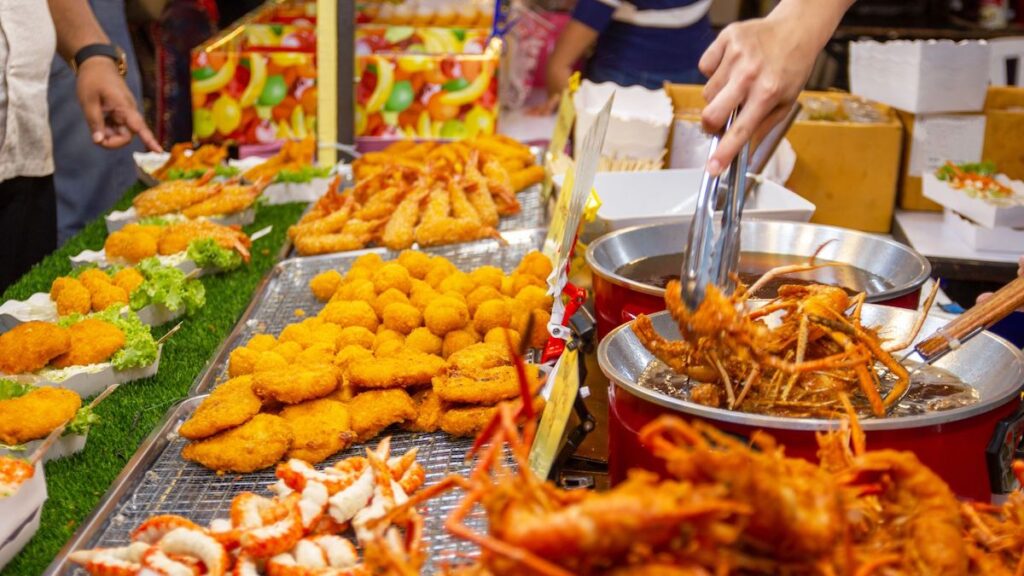 They vary by region, season, ingredients, and the cook who makes them. In addition to curries, there are standard stir-fried items like pad woon sen (bean thread noodles with vegetables), pad pak ruam (stir-fried mixed vegetables), and steamed pla tuu (mackerel). The variety is never-ending, like the creativity of Thai chefs. It is best to be willing to experiment. For the price of one hotel meal, a visitor can usually walk away with enough items to feed a horde of people back in their rooms.
They vary by region, season, ingredients, and the cook who makes them. In addition to curries, there are standard stir-fried items like pad woon sen (bean thread noodles with vegetables), pad pak ruam (stir-fried mixed vegetables), and steamed pla tuu (mackerel). The variety is never-ending, like the creativity of Thai chefs. It is best to be willing to experiment. For the price of one hotel meal, a visitor can usually walk away with enough items to feed a horde of people back in their rooms.
Thai Noodles
Noodles themselves have been a staple of Thai food and culture since their introduction by the Chinese centuries ago. They are made from several different types of flour and come in varying sizes. Most popular are the rice noodles, which come in three main varieties: sen mii, sen lek, and sen yai (strand noodles, thin noodles, and wide noodles, respectively). In addition, there are sen mii leuang (yellow egg noodles) and woon sen (clear bean thread noodles).
In Thailand, noodles end up both stir-fried and in soups, depending on what kind of stall you are at. Not to be missed is the satisfyingly exotic pad kee mao or ‘drunken man’s noodles’ made with wide noodles and the spicy additions of garlic, basil, and chilies. Other favorites at food stalls are pad thai, made with thin noodles and crushed peanuts, and pad see–ew, wide noodles fried with soy sauce and Chinese kale.
 In soups, it is fair to see every kind of noodle employed. Which type of noodle gets used is based on the eaters’ preferences. Rice noodles are used most commonly, with yellow noodles almost always ordered with BBQ pork in the Chinese Style (bah mii hmu daeng).
In soups, it is fair to see every kind of noodle employed. Which type of noodle gets used is based on the eaters’ preferences. Rice noodles are used most commonly, with yellow noodles almost always ordered with BBQ pork in the Chinese Style (bah mii hmu daeng).
Other types of tasty noodles include glass noodles, stringy noodles, ramen noodles,… oodles of noodles, well, you get the picture. There are also plenty of “big noodles”; in fact, you can even get your noodles in a knot in Thailand!
Rice in Thailand
Thai food just wouldn’t be Thai food without generous helpings of fluffy white or glutinous sticky rice. Rice adds bulk to your meal and cuts the heat of many of the Thai dishes that might unsuspectingly set your mouth ablaze. Many stalls cook your food to order and then serve it over rice. Some stalls with ready-prepared food laid out in pots serve their items with a heap of white rice on the side too. Food stalls serving items over rice are the cheapest eateries with the widest variety of food. They also have the added benefit for foreigners of requiring little or no language. You simply point at the desired dishes, and they scoop them onto the plate.
Thai Cooking Ingredients
Thailand is a lush country with highly fertile farmlands, abundant waters, and forests, providing its people with a diverse abundance of food ingredients. You can expect to see both the exotic and the familiar arrive at your table during your visit. Here is a list of common Thai ingredients by category that you should be acquainted with, along with their special qualities.
Meat
Traditionally, the easiest source of meat for the Thais has come from their abundant seas, lakes, and rivers. They make use of shrimp, squid, crabs, and untold varieties of fish in their cuisine. When near a seaside area, any visitor is encouraged to take advantage of fresh seafood and local preparation methods.
As for other meats, it is clear that the Thais have a love affair with pork and chicken. Pork and chicken win out because they are fairly cheap to come by and taste great in hundreds of different dishes. Although Thailand has cows and buffalo, these are not regularly eaten in Thai cuisine.
Though Penang Beef may be on the menu, many Westerners will find this a chewier offering than what they expected. Those wishing for a tender piece of steak are best off searching out a proper Western eatery known for its US Angus or Australian beef imports. Otherwise, stick to fish, chicken, and pork.
Herbs and Spices
Garlic: called ‘kratiem’, it is the heart of Thai spiciness. It appears abundantly in most curries, dips, sauces, and marinades, giving the foundation for the richness of Thai flavor sensations. It is also known as a natural antibiotic and helps reduce cholesterol levels. No wonder Thais can’t get enough.
Shallots: Thais use shallots, called ‘hua hom daeng’, in curry pastes and in their chili dips, among other ingredients. They are prized for their mild onion flavor without the full eye-watering knockout punch of their larger cousin.
Lemongrass: called ‘takhrai’, lemongrass is almost as popular as garlic for its use in curries, sauces, and marinades. The tall grass with fleshy stems can be seen growing in clusters outside the majority of rural Thai households. Its light, aromatic lemon scent adds depth to all manner of foods and is an essential among Thai ingredients.
Lime: Thais love one kind of lime for their leaves and another for their fruit. Deliciously aromatic kaffir lime leaves (bai makrut) are used in curry pastes for their bouquet and are also used to garnish many curries and soups. Common limes (manao) are used for their juice to add tang to many popular sour dishes, such as tom yam goong.
Galangal: called ‘kha’ in Thai, it is found in many Thai soups and curry pastes, utilized for its rich aroma and flavor-boosting abilities. For instance, it is the middle word in the staple tom kha gai, chicken, and coconut milk soup. The root is also carminative and aids in digestion. It is uncommon in other cuisines, but it is prominent in Thai cuisine.
Chillies: the Thais utilize several varieties of these hot little devils, called ‘prik’ in Thai. Most notably prik kii nu (literally ‘mouse dropping chilies’) which are very tiny and hide in the food quite easily as their name would suggest, waiting to surprise any unsuspecting diner. Prik chi faa (sky-pointing chilies) are slightly less hot and are used in the Thais’ favorite condiment, prik naam pla, ‘fish sauce with chilies.’
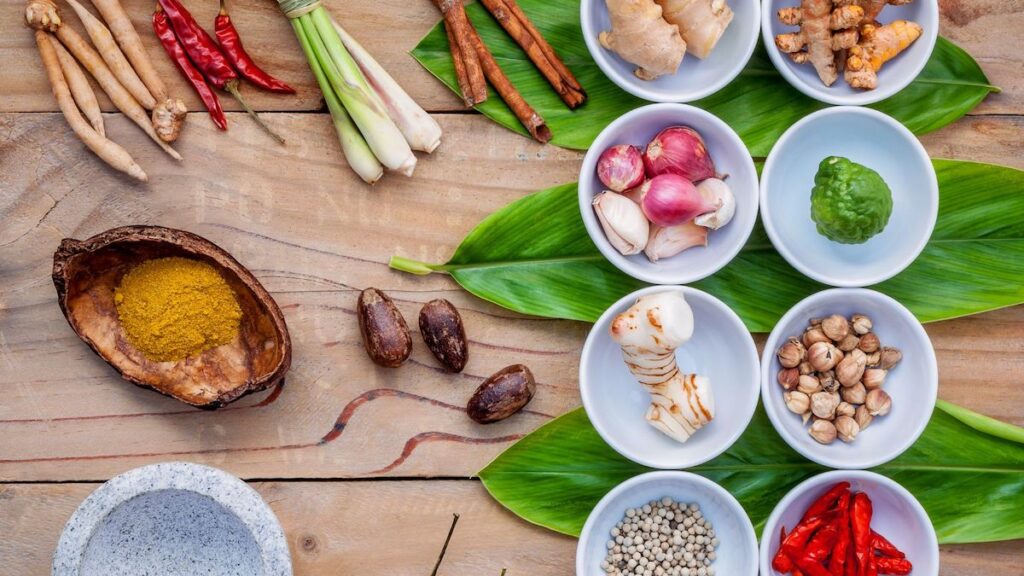 Pepper: native to Southeast Asia, peppercorns – whether green, black, or white – are all from the same plant and are called prik Thai, meaning ‘Thai pepper’. They have a long history of culinary use as ingredients in Thai soups, marinades, and garnishes. Expect to see green peppercorns garnishing seafood and chicken dishes, black pepper with garlic, and powdered white pepper atop your fried noodles and soup. Sometimes the dishes feature sprigs of whole peppercorns.
Pepper: native to Southeast Asia, peppercorns – whether green, black, or white – are all from the same plant and are called prik Thai, meaning ‘Thai pepper’. They have a long history of culinary use as ingredients in Thai soups, marinades, and garnishes. Expect to see green peppercorns garnishing seafood and chicken dishes, black pepper with garlic, and powdered white pepper atop your fried noodles and soup. Sometimes the dishes feature sprigs of whole peppercorns.
Turmeric: called ‘khamin’, it is used to flavor soups, curry pastes, and stewed dishes. It is most prevalent in southern-style seafood dishes, and in northern Burmese-influenced foods. It has a very strong flavor and adds that distinctive yellow color when added to foods such as the infamous khao soi gai.
Kra–chai: this is a relative of ginger with a strong flavor and smell and no equivalent name in English. These Thai ingredients are used in soups, curries, and curry pastes. It also has medicinal qualities, aiding in digestion as well as working as a diuretic and mild pain reliever.
Basil: Thais love basil for its aromatic properties that flavor foods and heighten the senses. ‘Bai horapha’ (Thai basil) which is most similar to the basil of the West, is commonly used in soups and as a garnish. ‘Bai krapao’ (holy basil) is similar in flavor, but only releases its oils upon cooking so it is always used in stir fry dishes like ‘pad kee mao’. Who knew that basil aids digestion and eases muscle cramping too?
Cilantro: Cilantro, also known as Pak chi, is an incredibly popular herb used in Thai cooking. It’s often used to garnish a variety of dishes, such as noodle soups, grilled meats, and curries. Its citrusy flavor and vibrant green color add a special touch to the food, making it appear even more inviting. This versatile ingredient has been incorporated into Thai cuisine for centuries and serves both culinary and medicinal purposes; its aroma is said to have calming properties that help improve overall well-being. To truly experience the unique flavors of Thailand, incorporating cilantro into your recipes is a must!
Pak Chi Farang: Even though it has “Farang” in the name, most Westerners are not familiar with this herb in Thai cuisine. It has a serrated, dandelion-shaped leaf with a strong herbal taste that works great with Thai food. In a really good “tom yum goong,” you can expect this flavorful leaf to be in there.
Popular Thai Vegetables
Chinese Kale: also known as morning glory, the dexterous vegetable ‘pak kannah’ is used in innumerable Thai dishes for color, flavor, and texture. It is the star of some stir-fry dishes like hmu tawt krob pat pak kannah—crispy pork with kale in oyster sauce.
Eggplants: Thailand is a country that uses all kinds of different ‘makrua’ in their dishes. Curries often have a couple varieties in them at once; there are small, pea-sized eggplants that pop in your mouth, as well as medium, round, egg–shaped ones. Long eggplants are roasted for a spicy dip with sticky rice.
Thai Pumpkins: the Thai are crazy about their pumpkins, called ‘fak tong’. They are used in main courses as well as desserts. In main dishes expect to see them fried in chunks with egg and garlic. For dessert, the Thais like them steamed with egg custard in the middle.
Fak Kiow: another Thai vine vegetable is this hard green gourd, whose peeled inner flesh cooks up like firm zucchini. They are not so common in restaurants, but their long shelf life makes them a key ingredient in numerous regional dishes throughout the country. It is another essential Thai ingredient the people definitely love. Seek out the spicy, red soup called ‘gaeng fak kiow’, and try not to giggle when you say it either.
Buap: this is an odd vegetable that, when peeled, is like a zucchini in texture and flavor but more closely resembles a cucumber. Buap is stir-fried with scrambled eggs and usually a few bits of pork, making a great mild dish served over rice.
Pak Bung: this is a Thai green that is often poorly translated as ‘swamp vegetable’ instead of the more appealing “water spinach.” Visitors to Thailand are missing out if they don’t try pak bung fai daeng a delicious stir-fry of pak bung, garlic, chilies, and soybean sauce that makes a giant flame as the cook tosses it in the air.
Bitter melon: called ‘maraa’, this is indeed a bitter melon. Soups and stir-fries take on the sourness, which is said to be medicinal. Many dishes actually balance out the taste with the addition of salty and savory ingredients.
Daikon Radish: this large root called ‘hua chai tao’ (good luck saying that one!) is used in a variety of dishes in Thailand. It is used fresh to flavor light soups and is also preserved for use as a soup garnish once again. The tuber is also sliced or mashed before being added to many other dishes.
Regional Thai Food
As with any country in the world, Thai food will vary by region, sometimes quite significantly. With this understanding, there is no “one” Thai food, but varieties of it where dishes will change based on local tastes and ingredients. Many of the dishes are also influenced by other cultures that have interacted with Thailand over the centuries. By sampling regional delights, you may find incredible flavors and a diversity you never dreamed possible in Thai food.
Regional Thai Cuisine in the North
The north, called Lanna, has been heavily influenced by its neighbors with respect to food. The region’s cuisine can be characterized as preferring curries and soups called gaeng. They also make heavy use of fragrant, spicy chili dips called “naam prik.” Northerners prefer salty, sour, and bitter flavors and consume very little sugar. They add depth to their curries and naam priks with kapi (fermented shrimp paste) or naam poo (fermented crab paste). Traditionally, they ate these curries and chili dips with sticky rice, fresh herbs, and vegetables.
 The north has originated its own unique cuisine, such as “everything but the kitchen sink” gaeng ho, which has stir-fried vegetables, meats, and woon sen noodles plus ample amounts of curry powder and turmeric. Another local favorite is jo pak kard, which stews kale and pork before a dash of sour tamarind is added. The result is a fragrant cabbage–type soup with a gentle sourness to it. However, some dishes are outright transplants of Burmese culture, like gaeng hang le, stewed pork curry with ginger. In the levels of flavor in gaeng hang le you can taste the spices of Burma, which are also a carry–over from India.
The north has originated its own unique cuisine, such as “everything but the kitchen sink” gaeng ho, which has stir-fried vegetables, meats, and woon sen noodles plus ample amounts of curry powder and turmeric. Another local favorite is jo pak kard, which stews kale and pork before a dash of sour tamarind is added. The result is a fragrant cabbage–type soup with a gentle sourness to it. However, some dishes are outright transplants of Burmese culture, like gaeng hang le, stewed pork curry with ginger. In the levels of flavor in gaeng hang le you can taste the spices of Burma, which are also a carry–over from India.
Visitors are invited to try any of the various naam prik chili dips available in the region when they have the chance. A small selection of naam prik is usually served at khantoke dinners, where you see a show of native Lanna costumes, music, and dance. Many khantoke dinners serve naam prik num (roasted green chili dip), and naam prik ong (tomato and pork chili dip), which suit Western tastes rather well. Deep northern foods such as naam prik poo made with fermented field crabs, garlic, and herbs, are likely to prove a challenge for Westerners both for taste and smell. Whatever chili dips or curries you eat, however, northern food is sure to leave an impression on you.
Regional Thai Cuisine From The Northeastern Isaan Region
The northeast, called Isaan, is renowned across Thailand for its delicious food. As poverty has sent many of its people throughout the country looking for a better life, they have brought their food culture with them. One staple Isaan dish the country has embraced is ‘som tam’ papaya salad.
Typically, garlic and chilies are pounded with a few tomatoes and long beans, then threads of green, unripe papayas are added. The recipe can vary greatly, but you can bet that an authentic Isaan som tam will be hot, salty, and musky, with plenty of mashed field crabs, and pla raa (fermented fish paste) thrown into the mix. Be warned: the version Thais eat among themselves differs greatly from what foreigners eat in restaurants!
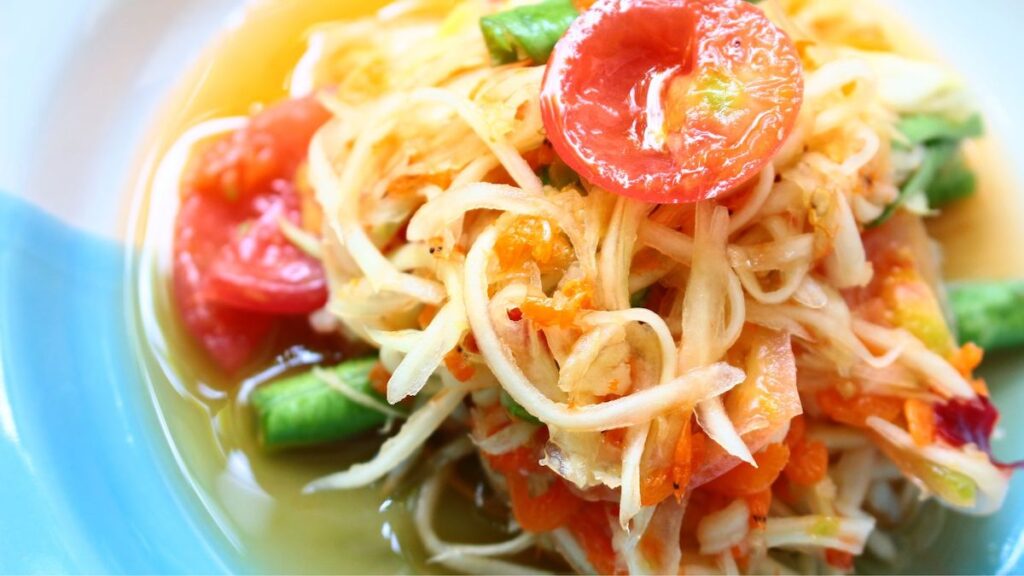 Another Isaan staple that is everywhere in the country is gai yang or grilled marinated chicken. The chicken is highly flavored by soaking in various secret concoctions, usually consisting of fish sauce, garlic, palm sugar, and crushed coriander seeds. The meat is then slowly roasted over coals until slightly dry and maybe even chewy. It makes a great meal when combined with som tam and hearty servings of khao niaw (sticky rice).
Another Isaan staple that is everywhere in the country is gai yang or grilled marinated chicken. The chicken is highly flavored by soaking in various secret concoctions, usually consisting of fish sauce, garlic, palm sugar, and crushed coriander seeds. The meat is then slowly roasted over coals until slightly dry and maybe even chewy. It makes a great meal when combined with som tam and hearty servings of khao niaw (sticky rice).
Any treatment of Isaan cuisine is incomplete without mentioning their use of insects as food. Insects were historically a cheap and quick source of protein in the Isaan area, which often suffered from droughts and poverty. As meat from animals was in short supply, eating insects became part of the culture. Most Isaan people eat insects without giving it a second thought, even craving them.
Street vendors sell a variety of fried insects that reflect what is in season at the time.Favorites in Isaan are grasshoppers, crickets, giant water beetles, and scorpions. Most are relatively light on flavor and more like a crunchy chip, with the main factor for Westerners being a psychological barrier. Eating insects is a must for those seeking a thrill or an exotic adventure.
Regional Thai Cuisine from Central Thailand
The Middle Kingdom, which includes Bangkok and Ayutthaya, has been the seat of the royal throne for centuries, so its preferences have been shaped by the refined tastes of the royal court as well as the various cultures surrounding it. Central Thai food is that which foreigners tend to take to most readily because of its use of sugar to balance the hot, sour, and spicy flavors that the other regions prefer unabated. The central Thais also prefer fluffy white rice (khao suay) to the sticky rice (khao niaow) enjoyed by the northern regions. In addition, the region’s relative wealth and refinement have led to a more Westernized cuisine, with less use of odd ingredients like insects and the powerful herbs found in the countryside.
Central Thai food has produced a few food ambassadors known worldwide that combine the best of all other surrounding regions. Typical in restaurants, buffets, and food stalls in the area is red curry ‘gaeng phet’ and green curry ‘gaeng kiaw waan’. They are made mild by the use of coconut milk and vary in color according to the chilies used in the paste.
 Perhaps the jewel of red curries is the royally influenced ‘gaeng phet pet yang’ – roasted red duck curry. In keeping with Middle Kingdom affluence and royal refinement, this dish puts luxurious pieces of duck in a sweet, spicy, red coconut curry with pineapple and cherry tomatoes. It is a must-try dish while in Thailand and is often found in restaurants and hotels, but rarely on the streets.
Perhaps the jewel of red curries is the royally influenced ‘gaeng phet pet yang’ – roasted red duck curry. In keeping with Middle Kingdom affluence and royal refinement, this dish puts luxurious pieces of duck in a sweet, spicy, red coconut curry with pineapple and cherry tomatoes. It is a must-try dish while in Thailand and is often found in restaurants and hotels, but rarely on the streets.
Central Thais also enjoy their noodles. They are a mainstay in stir-fries and soups. Particularly enjoyable fried are pad thai—small noodles with peanuts and a squeeze of lime—and pad see-ew—wide noodles fried with soy sauce and greens. Rad naa, which is wide noodles served with a pork-based (usually) sauce and slices of tender pork mixed in, is a particularly mild dish they eat.The dish is savory and soothing, with just enough sauce to be more like gravy. Other times, noodles show up abundantly in soups. Virtually anything imaginable can be combined with noodles to make a soup. It is all up to you to find what suits you best.
Regional Thai Cuisine from Southern Thailand
Southern Thai food is spicy and colorful, with influences from the Malay Peninsula and the local Islamic community. Food in the south has an emphasis on seafood and vegetables, which are both in abundance in the region. It offers all of the tropical flavors that foreigners have come to expect from Thai food, and then an extra dose of hot chilies for good measure.
Several dishes from the south are favorites among Westerners. One is the hearty meat-and-potato Muslim curry gaeng massaman. Traditionally, coconut milk and red curry paste are simmered with beef or chicken and potatoes. The resulting thick curry is sweet, spicy, and slightly creamy. It is a must-eat during your visit. Khao mok gai is another chicken recipe with Islamic influence by way of India. Saffron garlic rice is served with herb-baked chicken for a tasty Thai–Middle Eastern treat.
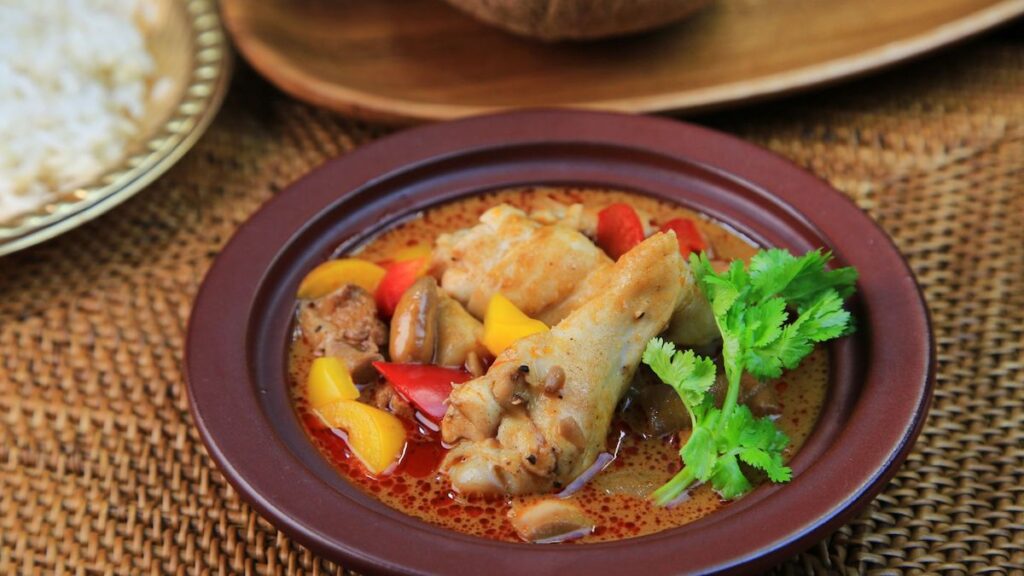 The south also offers up some very strong flavors that are famous among Thais, though perhaps not to Western tastes. Shrimp fried with satoh beans, or “pad ped satoh sai gung,” is a staple as much for the shrimp as for the use of the seasonal satoh bean. These pungent pulses, with their unique smell and taste, make this dish perfect for the adventurous. Those looking for a bigger thrill may attempt to eat gaeng tai pla, pickled fish intestine soup. This is the dish most Thais think of and swear by when they think of southern food. The obvious catch for the visitor is the list of strongly flavored ingredients such as pickled fish stomachs and sometimes pickled bamboo shoots as well. If you dare, try this spicy, sweet, and sour curry. The south has many delicious things to offer, whether you’re looking for a tame or exotic fare.
The south also offers up some very strong flavors that are famous among Thais, though perhaps not to Western tastes. Shrimp fried with satoh beans, or “pad ped satoh sai gung,” is a staple as much for the shrimp as for the use of the seasonal satoh bean. These pungent pulses, with their unique smell and taste, make this dish perfect for the adventurous. Those looking for a bigger thrill may attempt to eat gaeng tai pla, pickled fish intestine soup. This is the dish most Thais think of and swear by when they think of southern food. The obvious catch for the visitor is the list of strongly flavored ingredients such as pickled fish stomachs and sometimes pickled bamboo shoots as well. If you dare, try this spicy, sweet, and sour curry. The south has many delicious things to offer, whether you’re looking for a tame or exotic fare.

